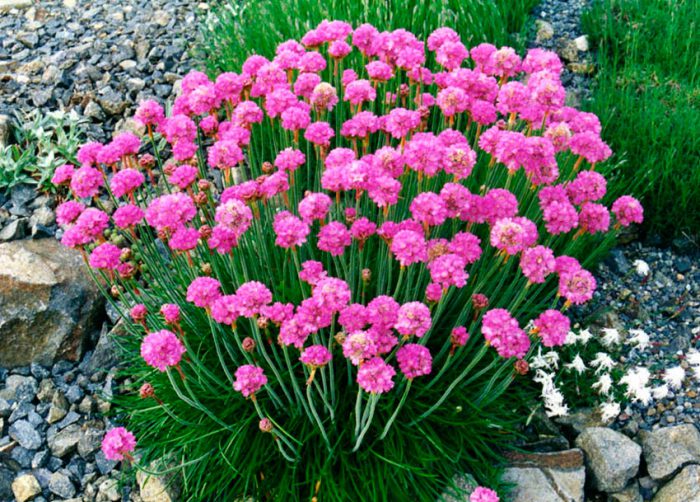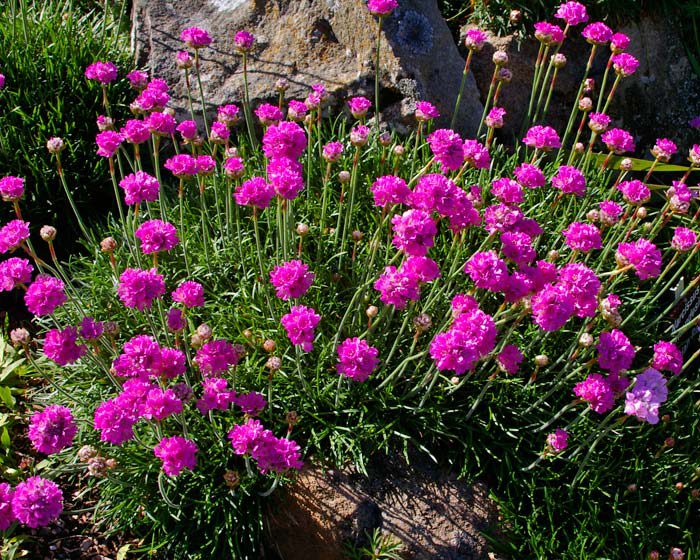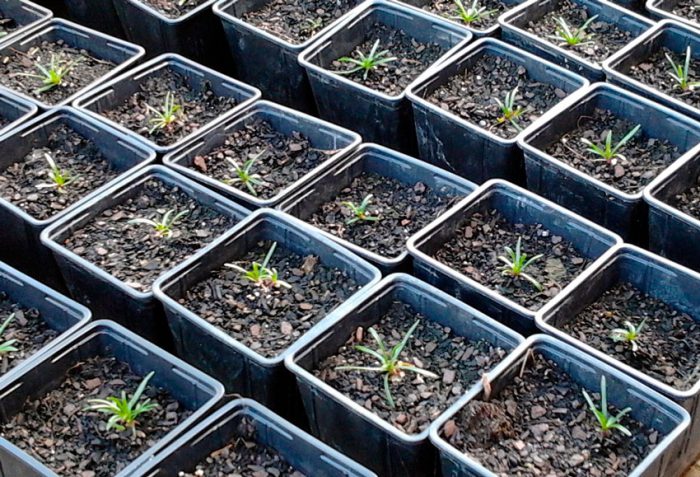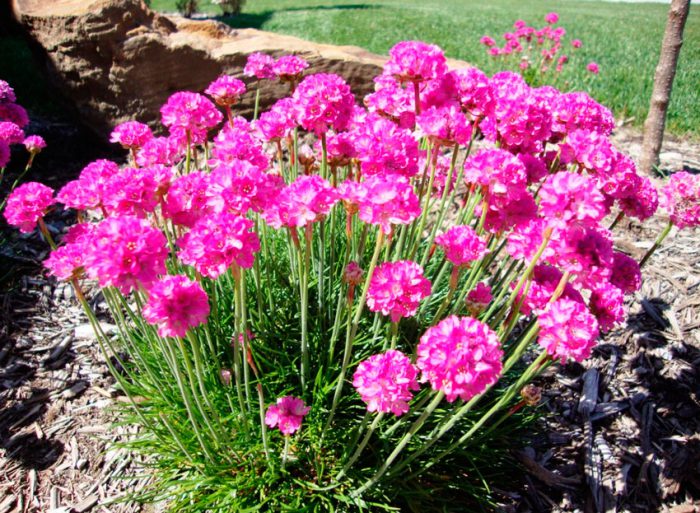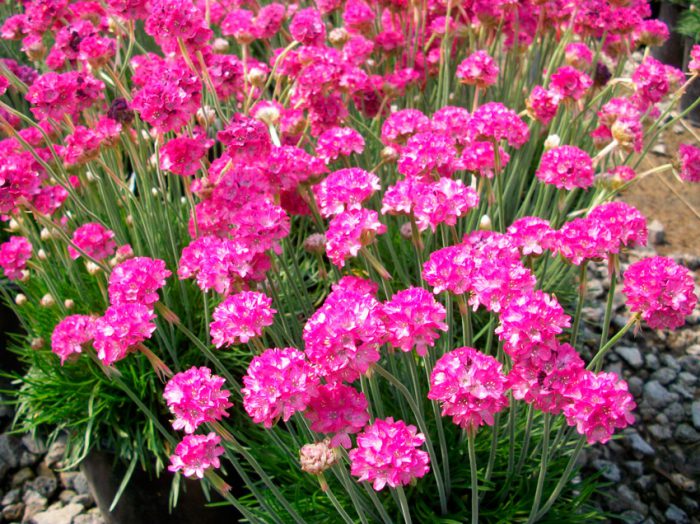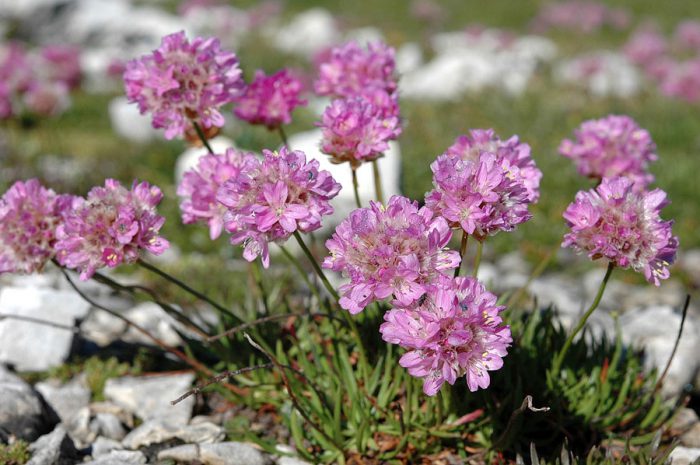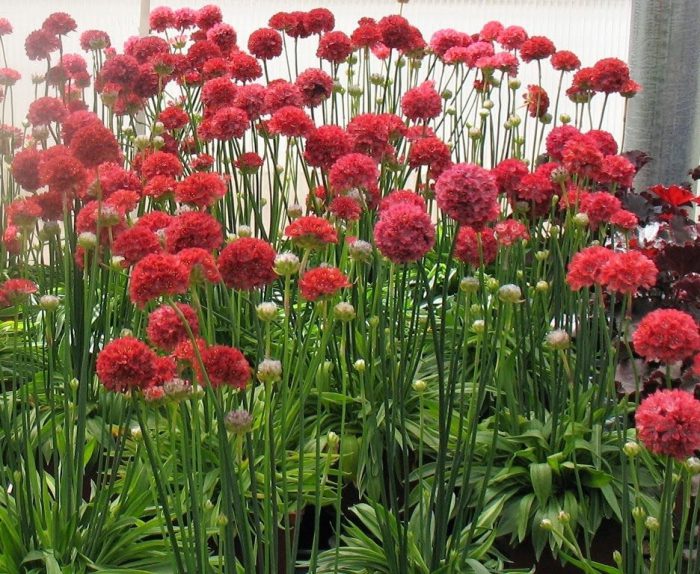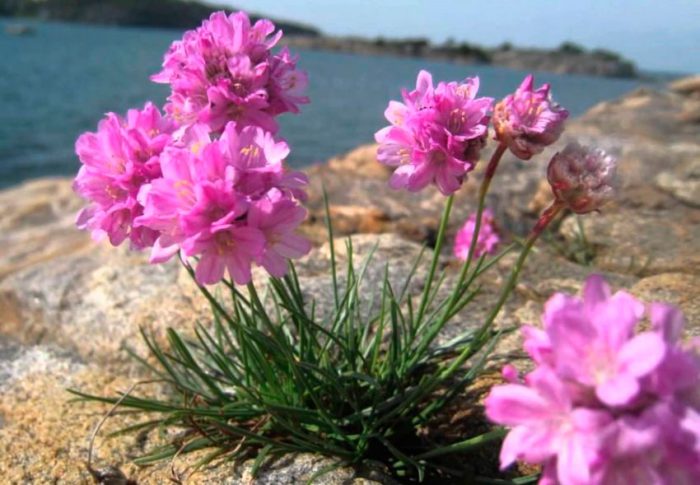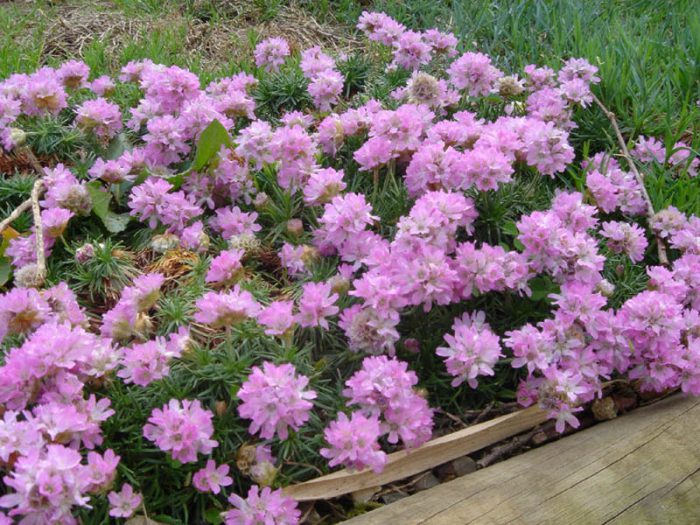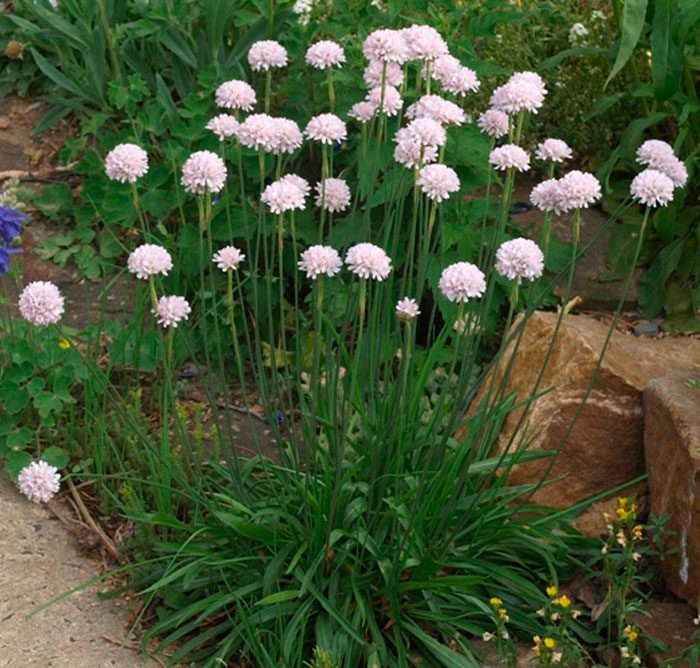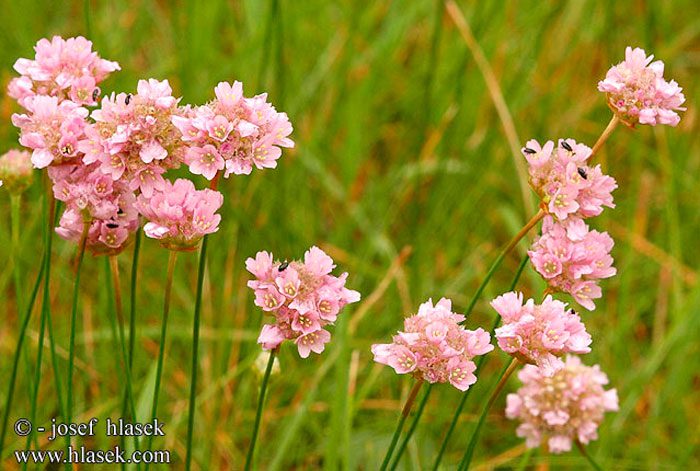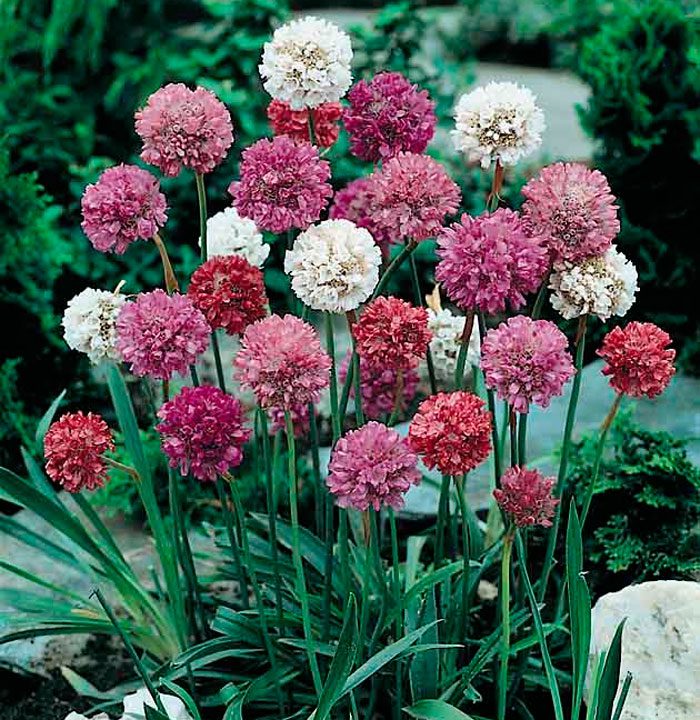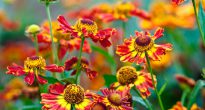Armeria (Armeria) belongs to the genus of herbaceous flowering perennials of the leaven family. This genus unites about 90 species of various plants. According to one version, the name of this flower comes from 2 Celtic words such as: "ar" - "near, nearby" and "mor" - "sea". So, in support of this version, a species was discovered that grows in armeria, while it prefers to grow in the coastal dunes. There is also a version that the name of the armeria comes from the word "armoires", this is how the bearded carnation was called in the old French language, and several types of armeria look like it. In natural conditions, such a plant can be found in the Mediterranean, America, Eastern Europe, Mongolia, and also in Siberia.
Content
- 1 Features of armeria
- 2 Growing armeria from seeds
- 3 Planting armeria in open ground
- 4 Care features
- 5 Armeria after flowering
- 6 Main varieties and species with photos and names
- 6.1 Armeria alpina (Armeria alpina)
- 6.2 Pseudoarmeria, or beautiful armeria (Armeria pseudarmeria)
- 6.3 Armeria maritima
- 6.4 Armeria soddy, or Armeria juniperifolia (Armeria juniperifolia, Armeria cespitosa)
- 6.5 Armeria Welwitschii
- 6.6 Armeria ordinary, garden (Armeria vulgaris)
- 6.7 Armeria beautiful (Armeria formosa)
Features of armeria
The height of this flower varies from 15 to 60 centimeters. It has a short tap root. A large number of sedentary all-edge leaf plates having a linear-lanceolate shape are collected in a root rosette. In doing so, they form cushions (dense curtains). The straight stem can be pubescent or smooth. Small flowers are part of the capitate inflorescences, while they can be colored pink, white or purple. Single-seeded fruit. Flowering lasts from late spring to late summer. The most popular species is the Armeria maritima. This type of armeria is grown in the same way as all other species, but it should be borne in mind that it prefers to grow in relative proximity to water bodies.
Growing armeria from seeds
Sowing
You can grow a plant from seeds using the non-seedling method, as well as through seedlings. In open soil, seeds are sown at the end of the autumn period, so in winter they will undergo natural stratification. You can also sow in the spring in the first days of March. In greenhouses for seedlings, sowing is carried out in the last days of February or the first - in March. Also, the reproduction of this flower can occur by self-seeding.When sowing seeds in open soil, as well as in a greenhouse, you need to take into account that they should not be buried too deep. So, it is recommended to sprinkle the seeds with a 5 mm layer of soil. Such seeds have a high germination rate.
Seedling
In order for the seedlings to be friendly, it is recommended to put the seeds on the refrigerator shelf for 7 days, and then immerse them in lukewarm water before sowing and take them out after 6-8 hours. The crops must be transferred to a well-lit and warm place. After 2 true leaves appear at the seedlings, they are picked into greenhouses for growing. There they should stay until they get stronger.
Planting armeria in open ground
What time to plant
After the leaf plates of the plants in the greenhouse become strong enough, they can be transplanted into open ground, but only if the frost does not return for sure. For such a plant, it is recommended to select the most sunny and well-heated area. Suitable soil should be slightly moist and slightly acidic, so rocky or sandy ground is excellent. Armeria does not grow well in soil where there is a lot of lime, so you need to fix it before planting. To do this, it is recommended to add ammonium nitrate to the soil or pour it with a solution of acetic acid.
How to plant an armeria
Preparing the soil should be done half a month before planting. To do this, it must be thoroughly loosened and organic fertilizers added to it. In the case of growing armeria as a single plant, it must be planted in pre-prepared holes, while the distance between the bushes should be from 30 to 40 centimeters, and they should also be at about the same distance from other plants. Armeria is installed in such a way that its leaf plates are not immersed in the soil, while the root collar should not be too deep. The required amount of soil is poured into the holes, after which it is tamped, and then irrigated. In the event that armeria is supposed to be grown with a solid carpet, a distance of more than 15–20 centimeters should not be made between plants. Instead of holes, it is better to make not very deep trenches. After planting, for the first 3 weeks, you need to water quite often, but you need to water the bushes only after the soil surface dries slightly. The flowering of plants grown from seeds begins only from the second year of life. From seeds, the seaside armeria should be grown in the same way.
Care features
It is very easy to care for such a flower. It is recommended to apply a complete mineral fertilizer to the soil before flowering. After that, the plant is fed in the same way 1 or 2 more times. Fading flowers must be cut off in time, and those peduncles on which flowers will no longer appear must be removed. As a result, the stored strength of the flower will be spent on the emergence of new buds. In the dry summer period, watering should be regular, but the soil should not be overmoistened. After the Armeria turns 5 years old, it is necessary to dig out a bush and divide it into parts, and then plant it. And then this procedure should be done once every 2 or 3 years, otherwise the flower will grow.
Diseases and pests
The plant is highly resistant to various diseases and harmful insects. However, if the acidity of the soil is less than necessary, then the armeria may have problems with spotting or aphids. To combat such misfortunes, radical pruning of the stems is used.
Armeria after flowering
Seed collection
In the event that armeria is grown on your garden plot, then there is no special need to collect its seeds, since it reproduces excellently by self-seeding. And you should not forget that the bushes will need to be planted regularly, while dividing them into divisions, and the sowing plants will multiply with their seeds, so you will definitely have enough planting material.In the same case, if you want to share the army with someone, then it is better to give some of the cut or cut a few cuttings. However, if you are in dire need of seeds, then the inflorescence, which will begin to fade, will need to be tied with a piece of gauze, which will prevent the seeds from falling onto the surface of the soil. A completely dried inflorescence must be carefully trimmed. The seeds need to be shaken out on a leaf. After that, they are cleaned of plant residues. When the seeds are dry, they must be poured into a paper bag.
Perennial wintering
Such a plant is highly resistant to frost, in this regard, they should not be covered for the winter, especially if the winter periods in this area are snowy enough. However, turfy armeria needs an obligatory shelter. You can cover the bushes with spruce branches, dry peat, and non-woven material. If a winter with little snow is predicted, then it is better to cover the army.
Main varieties and species with photos and names
The most popular among gardeners are about 10 types of armeria. They are grown in rabatkas, rocky gardens, in group plantings, rock gardens and as colored borders.
Armeria alpina (Armeria alpina)
Such a perennial forms dense cushions that can reach 15 centimeters in height and no more than 30 centimeters in diameter. Most of the linear-lanceolate leaf plates are able to survive during wintering. The capitate axillary inflorescences reach 30 mm in diameter, the color of the flowers is pale pink. The height of the peduncle is about 30 centimeters. Flowering lasts approximately 3-4 weeks and begins in June. Varieties:
- Alba - white flowers.
- Laucheana - carmine red flowers.
- Rosea - deep pink flowers.
Pseudoarmeria, or beautiful armeria (Armeria pseudarmeria)
In height, a bush of this type of armeria can reach 40 centimeters. Evergreen leaf plates are part of the root rosettes. The inflorescences consist of pink or white flowers. Flowering lasts from the first days of June to the last - August. Popular varieties:
- Joystick White - in this variety, the inflorescences are spherical, and they are painted white. In some cases, it is cultivated as an annual plant.
- Thrift - this variety belongs to undersized, while the height of the bush can reach as little as 20 centimeters.
- Red planet - in such a perennial plant, the inflorescences are spherical and red in color, peduncles in height can reach no more than 30 centimeters.
- Bees Ruby - the color of the flowers is deep pink, and the height of the bush is about 60 centimeters.
Armeria maritima
Under natural conditions, the plant of this species prefers to grow on the sea coasts. As a rule, the height of the bush does not exceed 20 centimeters. The diameter of the root outlet is also 20 centimeters. Narrow flat leaf plates have a linear shape and a greenish-blue color. The flowers are collected in capitate inflorescences, their color is lilac-pink. The flowers are covered with film bracts. Flowering begins in May and lasts approximately 70 days. In some cases, re-flowering occurs in autumn. Popular varieties:
- Louisiana - this variety has pink flowers.
- Dusseldorf Stolz - the flowers of this variety have a dark red color.
- Vindictive - the flowers of this plant are colored red.
- Bloodstone - inflorescences, consisting of small flowers, are painted in dark red.
Armeria soddy, or Armeria juniperifolia (Armeria juniperifolia, Armeria cespitosa)
The homeland of this type of armeria is the highlands of Portugal, as well as Spain. The height of this perennial plant can reach 15 centimeters. Narrow leaf plates have a linear shape; they are part of the root rosette, which can reach about 20 centimeters in diameter. The flowers are collected in capitate inflorescences, they can be pink or red. The inflorescences are framed by membranous bracts.The height of the peduncles is about 6 centimeters. This species differs in the abundance of its flowering, so, very often there are so many flowers and inflorescences that they completely cover the leaf plates and stems of the bush. Flowering begins in July and can last 40-50 days. This type of armeria is extremely negative about the stagnation of water in the root system. A hybrid plant created from maritime armeria and turf armeria is very popular, and it is called Zyunderman's armeria. Popular varieties:
- Brno - this undersized variety has purple double flowers.
- Beavans Variety - double flowers have a light pink color.
Armeria Welwitschii
Such a tall species in height can reach 35 centimeters. The length of the large sheet plates is 10 centimeters and the width is 5 centimeters. The capitate inflorescences include pink flowers, the diameter of which is 2 centimeters. It blooms very profusely and for a long time, from the beginning of the summer to the beginning of the winter period. This type of soil needs calcium-rich soil.
Armeria ordinary, garden (Armeria vulgaris)
The flower can reach a height of 60 centimeters. The length of the entire linear sheet plates is 12.5 centimeters, and the width is 1 centimeter. On the tops of the bare peduncles are capitate inflorescences. They are composed of fragrant flowers of carmine pink color. One bush can have up to 40 inflorescences.
Armeria beautiful (Armeria formosa)
Compact rosettes consist of narrow-linear evergreen leaf plates. Rounded tough shoots are erect. The diameter of the inflorescence is about 5 centimeters, and the color is red, white or pink. Abundant flowering ends only in October.
Also popular are such species as: Japanese armeria, Siberian, prickly, onion, arctic, etc.

